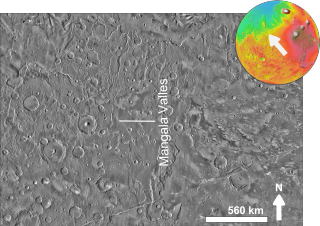Related Research Articles
Darwin most often refers to:

Phobos is the innermost and larger of the two natural satellites of Mars, the other being Deimos. The two moons were discovered in 1877 by American astronomer Asaph Hall. It is named after Phobos, the Greek god of fear and panic, who is the son of Ares (Mars) and twin brother of Deimos.
Adams may refer to:

Mount Erebus is the second-highest volcano in Antarctica, the highest active volcano in Antarctica, and the southernmost active volcano on Earth. It is the sixth-highest peak of an island and the second most prominent mountain in Antarctica after Mount Vinson. It has a summit elevation of 3,794 metres (12,448 ft). It is located in the Ross Dependency on Ross Island, which is also home to three inactive volcanoes: Mount Terror, Mount Bird, and Mount Terra Nova. The mountain was named by Captain James Clark Ross in 1841 for his ship, the Erebus.
Fridtjof Nansen (1861–1930) was a Norwegian polar explorer, scientist, diplomat, humanitarian, and Nobel laureate.
Mendel may refer to:
Halley may refer to:

The Mangala Valles are a complex system of criss-crossing channels on Mars, located in the Tharsis region and in the Memnonia quadrangle. They originated in the Hesperian and Amazonian epochs. They are thought to be an outflow channel system, carved by catastrophic floods, and the release of vast quantities of water across the Martian surface. This flooding was probably initiated by tectonic stretching and the formation of a graben, Mangala Fossa, at the channels' head, perhaps breaching a pressurized aquifer trapped beneath a thick "cryosphere" beneath the surface. The Mangala Valles contain several basins; after they filled, the overflow went through a series of spillways. One source of waters for the system was the Memonia Fossae, but water also probably came from a large basin centered at 40 degrees S.

Jezero is a crater on Mars in the Syrtis Major quadrangle, about 45.0 km (28.0 mi) in diameter. Thought to have once been flooded with water, the crater contains a fan-delta deposit rich in clays. The lake in the crater was present when valley networks were forming on Mars. Besides having a delta, the crater shows point bars and inverted channels. From a study of the delta and channels, it was concluded that the lake inside the crater probably formed during a period in which there was continual surface runoff.

Commemoration of Charles Darwin began with geographical features named after Darwin while he was still on the Beagle survey voyage, continued after his return with the naming of species he had collected, and extended further with his increasing fame. Many geographical features, species and institutions bear his name. Interest in his work has led to scholarship and publications, nicknamed the Darwin Industry, and his life is remembered in fiction, film and TV productions as well as in numerous biographies. Darwin Day has become an annual event, and in 2009 there were worldwide celebrations to mark the bicentenary of Darwin's birth and the 150th anniversary of the publication of On the Origin of Species.
Mars may contain ores that would be very useful to potential colonists. The abundance of volcanic features together with widespread cratering are strong evidence for a variety of ores. While nothing may be found on Mars that would justify the high cost of transport to Earth, the more ores that future colonists can obtain from Mars, the easier it would be to build colonies there.

Nakhlites are a group of Martian meteorites, named after the first one, Nakhla meteorite.

Peace Vallis is an ancient stream valley on the northern rim of Gale Crater on the planet Mars. It is notable for its associated alluvial fan which lies near the Mars Science Laboratory Curiosity landing site. The valley and alluvial fan provide evidence for geologically recent (Amazonian-aged) fluvial activity and sustained water flow on Mars. Recent high-resolution orbital images of Peace Vallis and its watershed also suggest that at least one glacial episode affected Gale crater. All of this evidence has implications for the history of water on Mars and the planet's long-term habitability. Understanding Peace Vallis and its fan also provides geologic context for the rocks observed on the ground by the Curiosity rover.

Gasa is an impact rayed crater in the Eridania quadrangle on Mars at 35.68° S and 230.72° W. and is 6.5 km in diameter. Its name was approved in 2009, and it was named after a place in Bhutan. Gullies are evident in the images. It is now believed that the impact that created Gasa happened in a larger crater whose floor was covered with debris-covered glaciers. The larger crater is known as Cilaos, it is located at 35.71° S and 230.52° W. and is 21.4 km in diameter. Its name was approved on 15 August 2016, and it was named after a place in the island of Réunion.
Catherine Margaret Corrigan, often known as Cari Corrigan, is an American scientist best known as a curator of the meteorite collection at the Smithsonian Institution. She is a scientist in the Department of Mineral Science at the National Museum of Natural History.

In summer 1965, the first close-up images from Mars showed a cratered desert with no signs of water. However, over the decades, as more parts of the planet were imaged with better cameras on more sophisticated satellites, Mars showed evidence of past river valleys, lakes and present ice in glaciers and in the ground. It was discovered that the climate of Mars displays huge changes over geologic time because its axis is not stabilized by a large moon, as Earth's is. Also, some researchers maintain that surface liquid water could have existed for periods of time due to geothermal effects, chemical composition or asteroid impacts. This article describes some of the places that could have held large lakes.

The Ross expedition was a voyage of scientific exploration of the Antarctic in 1839 to 1843, led by James Clark Ross, with two unusually strong warships, HMS Erebus and HMS Terror. It explored what is now called the Ross Sea and discovered the Ross Ice Shelf. On the expedition, Ross discovered the Transantarctic Mountains and the volcanoes Mount Erebus and Mount Terror, named after each ship. The young botanist Joseph Dalton Hooker made his name on the expedition.

Ogygis Undae is the only named southern hemisphere dune field on Mars. It is named after one of the classical albedo features on Mars, Ogygis Regio. Its name, which refers to Ogyges, a primeval mythological ruler in ancient Greece, was officially approved by the International Astronomical Union (IAU) on September 17, 2015. It is situated just outside Argyre Planitia, a plain located in the southern highlands of Mars. The dunes of Ogygis Undae extend from latitude −49.94°N to −49.37°N and from longitude 292.64°E to 294.93°E. They are centered at latitude −49.66°N, longitude 293.79°E (66.21°W), and extend approximately 87 km to the east and west from there. Ogygis Undae has an area of 1904 km2, and due to its large size is a primary subject for research on Martian dune morphology and sand composition.

Louth is an impact crater on Mars located at 70.19°N 103.24°E in the Mare Boreum quadrangle. Located within Vastitas Borealis, the crater has a diameter of 36.29 kilometres and is named after Louth, a town in Ireland.
References
- ↑ Miličić, D.; Lučić, L.; Pavković-Lučić, S. (2011). "How Many Darwins? – List Of Animal Taxa Named After Charles Darwin" (PDF). Natura Montenegrina. 10 (4): 515–532. Archived from the original (PDF) on 2015-07-24.
- ↑ Jozwiak, Piotr; Rewicz, Tomasz; Pabis, Krzysztof (2015). "Taxonomic etymology – in search of inspiration". ZooKeys (513): 143–160. doi: 10.3897/zookeys.513.9873 . PMC 4524282 . PMID 26257573.